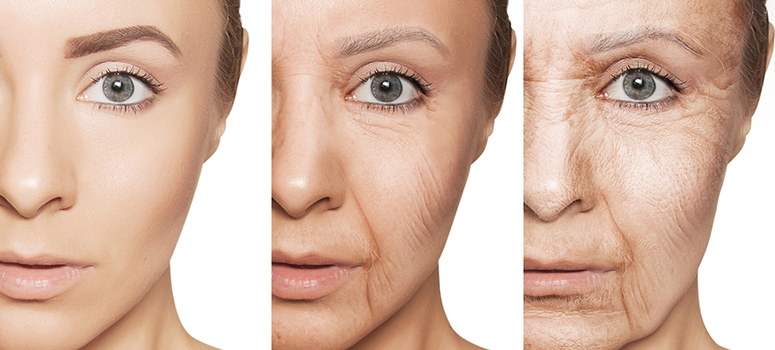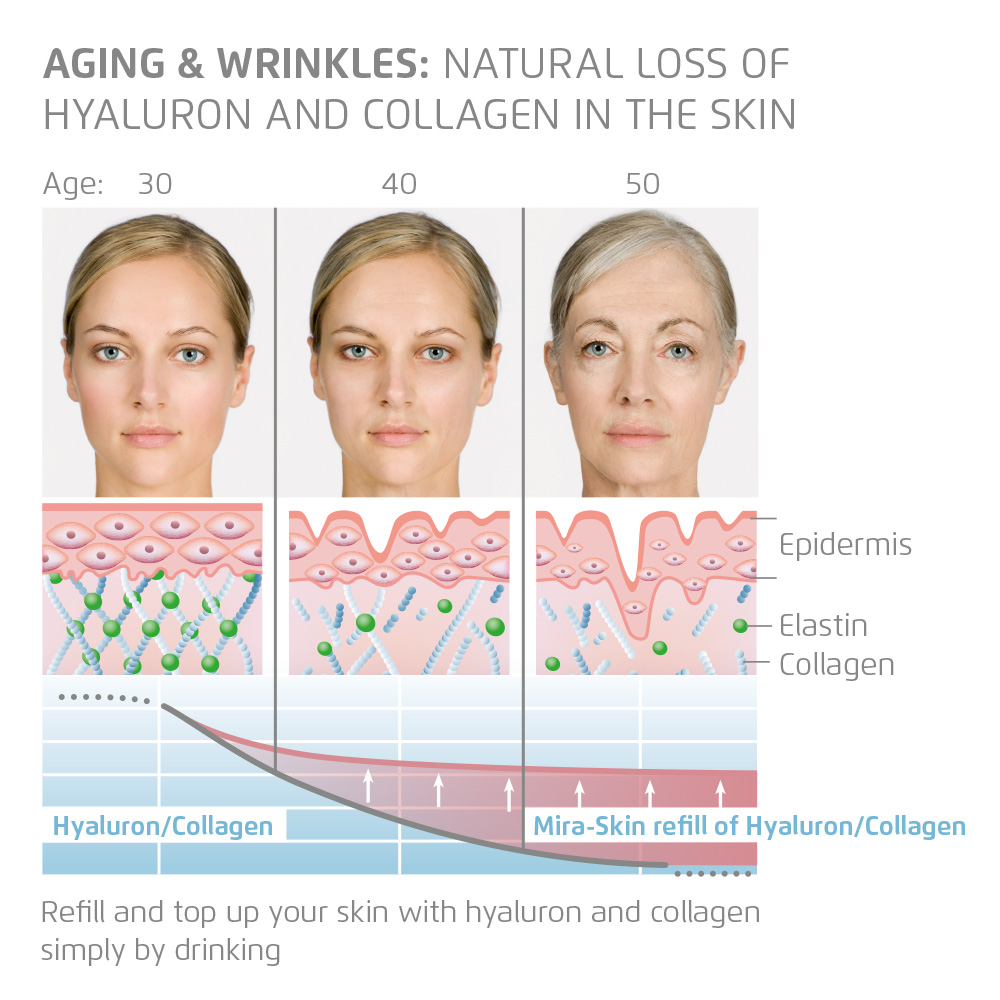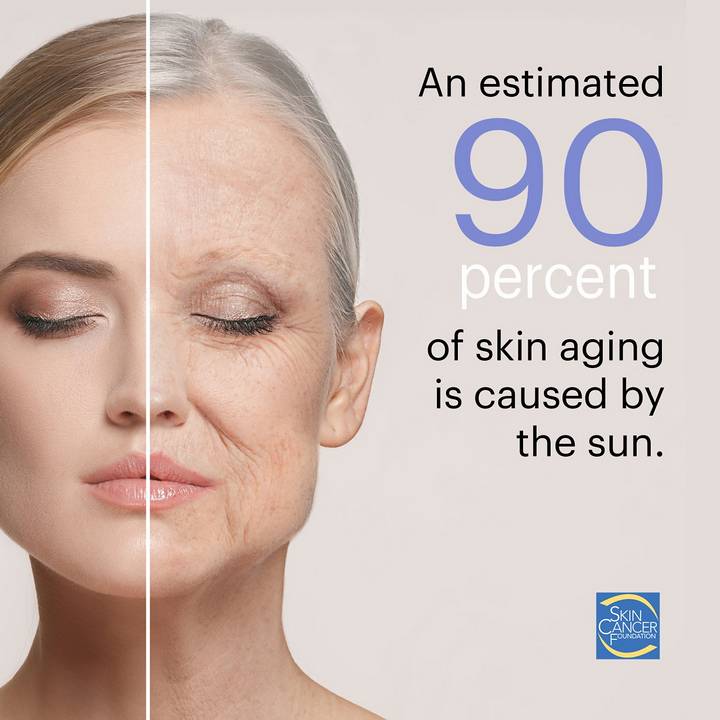As we age, our skin goes through various changes. These changes are a natural part of the aging process and are often visible on our face, neck, hands, and other parts of the body. However, sometimes these changes can occur prematurely, leading to what is known as “skin aging.” In this article, we will explore the causes, signs, and prevention methods for skin aging.
Table of Contents
ToggleWhat is Skin Aging?

Skin aging, also known as “dermatoheliosis,” is the process of natural or premature changes that occur in the skin as we grow older. The skin is the largest organ in the body and acts as a protective barrier against environmental factors such as UV rays, pollution, and toxins. As we age, the skin loses its ability to protect itself, leading to visible changes in its appearance and texture.
There are two types of skin aging: intrinsic and extrinsic. Intrinsic aging is a natural process that occurs due to genetics and the passage of time. Extrinsic aging, on the other hand, is caused by external factors such as exposure to sunlight, pollution, and lifestyle choices like smoking and poor diet.
The most visible sign of skin aging is the formation of wrinkles, fine lines, and sagging skin. Other signs include dryness, age spots, uneven skin tone, and loss of elasticity. While skin aging is a natural phenomenon, certain factors can accelerate the process, leading to premature aging.
Causes of Skin Aging

What Can Skin Aging Cause?
Skin aging can cause a wide range of changes in the appearance and health of the skin. Some of the common effects of skin aging include:
- Wrinkles and fine lines: As we age, the production of collagen and elastin – proteins responsible for keeping the skin firm and elastic – decreases, leading to visible wrinkles and fine lines.
- Sagging skin: As the skin loses its elasticity, it becomes less able to hold up against gravity, resulting in sagging skin.
- Dryness and rough texture: With age, the skin produces less sebum, which leads to dryness and a rough texture.
- Age spots: Exposure to UV rays can cause an increase in the production of melanin, leading to dark spots or “age spots” on the skin.
- Uneven skin tone: As we age, the skin’s ability to renew itself slows down, resulting in an uneven distribution of pigmentation.
- Reduced wound healing: The skin’s ability to heal and regenerate itself also decreases with age, making it more prone to injuries and slower to heal.
Causes of Early Skin Aging
While aging is inevitable, certain factors can accelerate the process, leading to early signs of skin aging. These include:
.Sun Exposure: UV rays penetrate the skin, damaging DNA and causing wrinkles and age spots. Excessive exposure breaks down collagen and elastin, leading to sagging skin.
Poor Diet: Processed foods, sugar, and unhealthy fats promote oxidative stress and inflammation, accelerating aging by impairing skin repair.
Smoking: Cigarette chemicals harm collagen and elastin, causing wrinkles and dullness. Reduced blood flow leads to dryness and discoloration.
Pollution: Air pollutants and cigarette smoke induce oxidative stress and inflammation, clogging pores and resulting in dull, congested skin.
Lack of Sleep: Inadequate rest hampers skin repair and elevates cortisol levels, degrading collagen and elastin and causing wrinkles.
Stress: Chronic stress increases cortisol, breaking down collagen and reducing skin moisture, resulting in dryness and dullness.
Signs and Prevention of Skin Aging

Signs of Skin Aging
As we age, our skin undergoes visible changes, including:
- Fine lines and wrinkles: Common around the eyes and mouth, and on the forehead and cheeks.
- Sagging skin: Loss of elasticity leads to jowls, double chin, and general sagging.
- Dryness and rough texture: Reduced oil production causes dryness, flakiness, and roughness.
- Age spots: Increased melanin production from UV exposure results in dark spots.
- Uneven skin tone: Slower cell turnover leads to uneven pigmentation and a blotchy complexion.
- Dullness: Decreased skin renewal leads to a lackluster complexion.
Prevention of Skin Aging: Essential Tips for Youthful Skin
Slowing down and preventing premature skin aging is achievable with simple steps:
- Sun Protection: Shield yourself from harmful UV rays by wearing sunscreen daily, seeking shade, and avoiding tanning beds.
- Healthy Diet: Opt for a balanced diet rich in fruits, vegetables, and lean proteins to provide essential nutrients and antioxidants for skin health.
- Quit Smoking: Smoking accelerates skin aging, so consider quitting to preserve your skin’s youthfulness.
- Pollution Protection: Minimize exposure to pollution by avoiding heavily polluted areas and cleansing your skin thoroughly daily.
- Adequate Sleep: Aim for 7-9 hours of quality sleep each night to allow your skin to repair and rejuvenate.
- Stress Management: Incorporate stress-reducing practices like meditation and relaxation techniques into your daily routine to promote skin health and overall well-being.
Signs and Prevention of Computer Virus

Signs of a Computer Virus
Like the human body, computers are also susceptible to viruses. A computer virus is a malicious software program that can infect your computer and cause damage to its operations or steal sensitive information. Some of the signs that your computer may be infected with a virus include:
- Slow performance: If your computer suddenly becomes slow and takes a long time to load programs, it could be a sign of a virus.
- Frequent crashes: A virus can also cause your computer to crash frequently, especially when running certain programs or opening specific documents.
- Pop-up ads: If your computer starts displaying pop-up ads when you’re not browsing the internet, it could be a sign of adware – a type of malware that displays unwanted advertisements.
- Unusual error messages: If you start getting error messages that you haven’t seen before, it could be a sign of a virus infecting your computer.
- Changes in settings or programs: Viruses can also make changes to your computer’s settings or programs without your knowledge. These changes may include adding new programs, changing your homepage, or modifying your security settings.
Prevention of Computer Virus
Preventing a computer virus from infecting your system is essential for protecting your data and maintaining the health of your computer. Some steps you can take to prevent viruses include:
Install Anti-Virus Software
The first line of defense against viruses is to install reputable anti-virus software on your computer. Make sure to keep the software up-to-date and run regular scans to detect and remove any potential threats.
Be Cautious When Opening Emails
Emails are a common way for viruses to spread. Be careful when opening emails from unknown senders, and do not open any attachments or click on links unless you are sure they are safe.
Use a Firewall
A firewall acts as a barrier between your computer and the internet, blocking unauthorized access and preventing viruses from entering your system. Make sure to turn on your computer’s firewall or install a third-party firewall for added protection.
Update Your Operating System and Software
Software developers often release updates to fix bugs and security vulnerabilities. Make sure to keep your operating system and other software up-to-date to prevent viruses from exploiting these vulnerabilities.
Use Strong Passwords
Make sure to use strong, unique passwords for all your online accounts. This will make it more difficult for hackers to access your personal information and infect your computer.
Signs and Prevention of Child Abuse

Signs of Child Abuse
Child abuse is a serious and pervasive issue that affects millions of children worldwide. It refers to any action or inaction by a parent, caregiver, or another adult that causes harm or puts a child at risk for harm. Some of the signs that a child may be experiencing abuse include:
- Unexplained injuries: Frequent bruises, burns, or other injuries that cannot be explained or do not match the child’s explanation could be a sign of physical abuse.
- Changes in behavior: Children who are being abused may suddenly become withdrawn, anxious, aggressive, or exhibit other behavioral changes.
- Fear of going home: If a child expresses fear or reluctance to go home after school or daycare, it could be a red flag for abuse.
- Difficulty walking or sitting: Bruises or injuries in the genital area could indicate sexual abuse.
- Poor hygiene: Neglect is a form of abuse and can result in poor personal hygiene, dirty clothing, or untreated medical conditions.
- Sudden changes in academic performance: Children who are experiencing abuse may struggle with their schoolwork, lose interest in activities they used to enjoy, or have trouble concentrating.
Prevention of Child Abuse
Preventing child abuse requires a collective effort from parents, caregivers, and society as a whole. Here are some steps we can take to prevent child abuse:
Educate Yourself
To prevent child abuse, we must first understand what it is and how it can manifest. Educate yourself on the different types of child abuse, their signs and symptoms, and how to report suspected abuse.
Create Safe Environments
Parents and caregivers should create safe and nurturing environments for children to grow up in. This includes providing basic needs such as food, shelter, and clothing, and offering love, support, and guidance.
Furthermore, make sure to child-proof your home to prevent accidents and injuries that could lead to abuse.
Communicate Effectively
Effective communication between parents and children is crucial for preventing child abuse. Encourage open and honest communication, and create a safe space for children to express themselves without fear of judgment or punishment.
Teach Body Safety Rules
Teaching children about body safety rules can help them understand what is appropriate and inappropriate behavior from adults. This includes teaching them about boundaries, privacy, and the difference between good and bad touches.
Report Suspected Abuse
If you suspect a child is being abused, it is essential to report it to the authorities. You can contact your local child protective services agency or law enforcement for assistance.
Vector illustration with reasons of aging, isolated on the white
Signs of Dehydration and Prevention

Signs of Dehydration
Dehydration occurs when the body loses more fluids than it takes in, leading to an imbalance of electrolytes in the body. Some of the signs that you may be dehydrated include:
- Dry mouth and thirst: The first sign of dehydration is usually a dry mouth and increased thirst.
- Dark urine: If you are dehydrated, your urine may become darker in color and have a strong odor.
- Fatigue and dizziness: As the body becomes dehydrated, it may start to feel fatigued and dizzy.
- Headaches: Dehydration can also cause headaches and migraines.
- Confusion and irritability: In severe cases, dehydration can affect cognitive function, leading to confusion and irritability.
- Decreased urine output: A decrease in urine output is a sign that the body is trying to conserve fluids.
Prevention of Dehydration
Preventing dehydration requires staying hydrated and replenishing lost fluids. Here are some ways to prevent dehydration:
Drink Enough Water
The most effective way to prevent dehydration is to drink enough water throughout the day. The amount of water you need depends on various factors, such as your age, gender, activity level, and climate. However, a general rule of thumb is to drink eight 8-ounce glasses of water per day.
Eat Foods High in Water Content
In addition to drinking water, you can also stay hydrated by consuming foods high in water content. These include fruits and vegetables such as watermelon, tomatoes, cucumbers, and lettuce.
Limit Diuretic Beverages
Some beverages, such as coffee, tea, and alcohol, have diuretic effects, meaning they can increase urine output and dehydrate the body. Limit your intake of these drinks and make sure to drink plenty of water to counter their effects.
Stay Hydrated During Physical Activity
When engaging in physical activity, make sure to drink plenty of water to replenish lost fluids. Aim to drink 8-16 ounces of water for every hour of physical activity.
Monitor Your Urine Color
Monitoring your urine color can help you determine if you are adequately hydrated. Clear or light yellow urine is a sign of proper hydration, while dark yellow or amber-colored urine may indicate dehydration.
Cholera Signs and Symptoms and Prevention
Signs and Symptoms of Cholera
Cholera is a bacterial infection that affects the small intestine, causing severe diarrhea and dehydration. Some of the signs and symptoms of cholera include:
- Watery diarrhea: The most common symptom of cholera is profuse, watery diarrhea.
- Vomiting: Cholera may also cause vomiting, which can lead to further dehydration.
- Dehydration: As the body loses fluids, it can become severely dehydrated, leading to symptoms such as dry mouth, increased thirst, rapid heartbeat, and low blood pressure.
- Muscle cramps: Dehydration can also cause muscle cramps and weakness.
- Shock: In severe cases, cholera can lead to shock, which is characterized by a rapid and weak pulse, cold and clammy skin, and loss of consciousness.
Prevention of Cholera
The best way to prevent cholera is to take precautions to avoid exposure to the bacteria responsible for the infection. Here are some steps you can take to prevent cholera:
Practice Good Hygiene
Washing your hands regularly with soap and water is one of the most effective ways to prevent the spread of cholera. Make sure to wash your hands before preparing or eating food, after using the bathroom, and after caring for someone who is sick.
Drink Safe Water
Cholera is typically transmitted through contaminated water. To prevent infection, make sure to drink safe water from a reliable source. If you are unsure about the safety of the water, boil it for at least one minute before drinking.
Eat Cooked Food
Avoid eating raw or undercooked seafood, fruits, and vegetables, as they may be contaminated with the bacteria that cause cholera.
Get Vaccinated
If you are traveling to areas where cholera is common, consider getting vaccinated against the disease. The cholera vaccine provides up to 90% protection against the disease and is recommended for travelers to certain countries in Africa, Asia, and the Caribbean.
Prevention Signs and Tags
What are Prevention Signs and Tags?
Prevention signs and tags are visual tools used to communicate important safety information and prevent accidents and injuries. These signs and tags are used in various settings, including workplaces, public spaces, and construction sites, to remindindividuals of potential hazards and the necessary precautions to take. Prevention signs are typically displayed in prominent locations where they can be easily seen, while tags are attached to equipment or machinery to provide specific instructions or warnings.
Importance of Prevention Signs and Tags
Prevention signs and tags play a crucial role in maintaining a safe environment and preventing accidents. By effectively communicating safety information, these visual tools help raise awareness about potential hazards and remind individuals to follow safety protocols. In workplaces, prevention signs and tags are essential for complying with occupational health and safety regulations and reducing the risk of injuries and incidents.
Types of Prevention Signs
There are various types of prevention signs that serve different purposes and convey specific messages. Some common types of prevention signs include:
- Warning Signs: Warning signs alert individuals to potential dangers or hazards in a specific area. These signs typically feature a yellow background with black text and symbols to indicate caution.
- Danger Signs: Danger signs indicate immediate hazards that pose a threat to health and safety. These signs have a red background with white text and symbols to convey the seriousness of the situation.
- Safety Instruction Signs: Safety instruction signs provide guidance on safe practices and procedures to follow in a particular area. These signs often feature blue and white colors with instructional text or diagrams.
- Prohibition Signs: Prohibition signs prohibit certain actions or behaviors to prevent accidents or injuries. These signs typically have a red circle with a diagonal line across a black symbol, indicating what is not allowed.
Benefits of Using Prevention Signs and Tags
The use of prevention signs and tags offers several benefits in promoting safety and preventing accidents:
- Increased Awareness: By prominently displaying prevention signs and tags, individuals are more likely to be aware of potential hazards and take necessary precautions to avoid accidents.
- Compliance with Regulations: Employers can ensure compliance with safety regulations by using appropriate prevention signs and tags in the workplace, reducing the risk of fines or penalties.
- Reduced Risk of Accidents: Clear and visible prevention signs help reduce the likelihood of accidents and injuries by alerting individuals to dangers and guiding them on safe practices.
- Improved Communication: Prevention signs and tags provide a universal language for communicating safety information, regardless of language barriers, ensuring that everyone understands the risks involved.
- Enhanced Safety Culture: Consistent use of prevention signs and tags fosters a culture of safety in the workplace or public spaces, where safety is prioritized and valued by all individuals.
Best Practices for Using Prevention Signs and Tags
To maximize the effectiveness of prevention signs and tags, consider the following best practices:
- Ensure that signs are clear, concise, and easy to understand at a glance.
- Use symbols and pictograms in addition to text to enhance comprehension, especially in multicultural environments.
- Regularly inspect and maintain signs to ensure visibility and legibility.
- Place signs at eye level and in well-lit areas for maximum visibility.
- Provide training to employees on the meaning of different signs and tags and the actions to take in response.
By following these best practices and utilizing prevention signs and tags effectively, organizations can create a safer environment for their employees and the public, ultimately reducing the risk of accidents and injuries.
Conclusion
Skin aging is a natural process that occurs as we grow older, but it can also be accelerated by various factors such as UV radiation, pollution, smoking, and poor skincare habits. Understanding the causes and signs of skin aging is essential in order to take preventive measures and maintain healthy, youthful skin.
By incorporating a skincare routine that includes sun protection, hydration, a healthy diet, and avoiding harmful habits, you can help slow down the aging process and keep your skin looking radiant and youthful. Additionally, seeking professional advice and treatments from dermatologists or skincare experts can further enhance the health and appearance of your skin.
Remember, prevention is key when it comes to skin aging. Taking care of your skin from an early age and being mindful of your lifestyle choices can go a long way in preserving its youthfulness and vitality. Embrace your skin’s natural beauty and age gracefully with proper care and attention.








